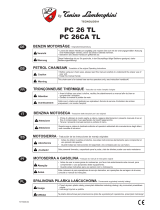
25
I
GB
F
D
E
SK
P
GR
TR
CZ
RUS
UK
PL
own that are other than routine
maintenance. Call specialised and
authorised workshops only.
19. Never start up the chainsaw without the
chain cover fitted.
20. If your chainsaw is no longer usable, dispose
of it properly without damaging the
environment by handing it in to your local
Dealer who will arrange for its correct
disposal.
21. Only loan your saw to expert users who are
completely familiar with saw operation and
correct use. Give other users the manual
with operating instructions, which they
should read before using the saw.
22. All saw service, other than the operations
shown in the present manual, should be
performed by competent personnel.
23. Keep this manual on hand and consult it
before each use of the tool.
24. Please note that the owner or the user is
responsible for any accidents or damage to
third parties or their property.
SAFETY PROTECTIVE CLOTHING
Major cases of chainsaw accidents happen
when the chain hits the operator. While
working with the chainsaw, always use safety
protective approved clothing. The use of
protective clothing does not eliminate injury
risks, but it reduces the injury effects in case of
accident. Consult your trusted supplier to choose
an adequate equipment.
The clothing must be proper and not an obstacle.
Wear adherent anti-cut clothing. Anti-cut
jackets, dungarees and leggings are the ideal.
Do not wear clothes, scarves, ties or bracelets
that can stuck into woods or twigs. Tie up and
protect long hair (example with foulards, cap,
helmets, etc.)
Safety shoes or boots having skid-proof sole
and anti-piercing insert.
Wear protective helmet in places where there
can be falling objects.
Wear protective goggles or face screens!
Use protections against noises; for example
noise reduction ear guards or earplugs.
The use of protections for the ear requests
much more attention and caution, because the
perception of danger audio signals (screamings,
alarms, etc.) is limited.
Wear anti-cut gloves.
When working on trees, wear gloves and
shoes suitable for tree climbing.
4. FITTING
BAR AND CHAIN
WARNING - Always wear work gloves
during assembly procedures. Use only
bars and chains recommended by the
manufacturer (page 37).
- Pull the guard (Fig. 3) towards the front handle
to check that the chain brake is not on.
- Remove the bar nut (A) and the chain cover
(B, Fig. 4).
- Remove and discard the plastic shim from the
bar studs (C, Fig. 5).
- Take the chain tightener pawl (D, Fig. 5) to the
limit stop, by unscrewing all the chain
tightener screw (L).
- Place the bar (F, Fig. 5) onto the stud (N).
- Fit the chain (H, Fig. 6) inside the sprocket (E)
and the bar groove (M). Pay attention to the
direction of rotation of the chain (Fig. 8).
- Put down the chain cover, inserting it into its
housing and, keeping it pressed against the
bar, screw on the chain tightener screw
(L, Fig. 7) so that the pawl (D, Fig. 5) goes into
the hole (G) of the bar.
- Fit the chain cover and the relative nuts
without tightening them.
- Tension the chain by means of the tensioning
screw (L, Fig. 7).
- Hold the tip of the guide bar up and tighten
the chain cover nut securely (Fig. 9). The
tightening torque is 1,5 kgm (15 Nm). The
chain should be taut but turn freely by hand
(Fig. 10).
- The chain is tensioned correctly when it can
be pulled upwards a few millimetres (Fig. 10).





















